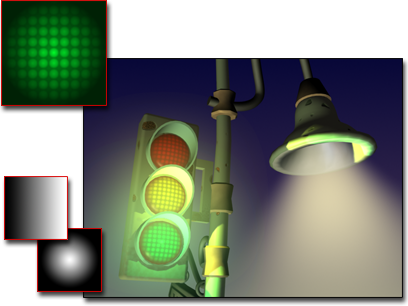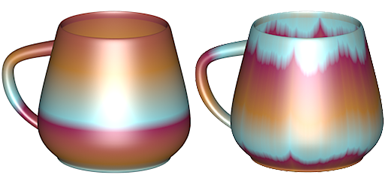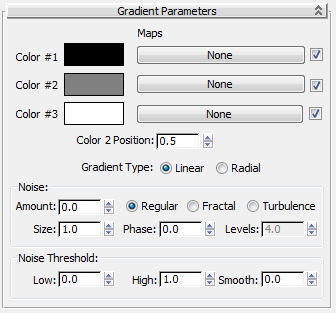 Command entry:
Command entry:

Material Editor

Material/Map Browser

Maps

Standard

Gradient
Gradients shade from one color to another. You specify two or three colors for the gradient; 3ds Max interpolates intermediate values. Gradient maps are 2D maps.
TipYou can swap colors by dragging one color swatch over another, then clicking Swap in the Copy or Swap Colors dialog. To reverse
the overall direction of the gradient, swap the first and third colors.
Procedures
To change a gradient color:
- On the Gradient Parameters rollout, click a color swatch to display the Color Selector.
- Adjust the color.
- Click one of the other color swatches.
- Adjust the color.
To choose the kind of gradient:
To use a map for a color in the gradient:
- On the Gradient Parameters rollout, click a map button to assign a map to a color.
Alternatively, use the Slate Material Editor to wire a map to the Color 1, Color 2, or Color 3 component.
To adjust the position of the second color:
- Change the Color 2 Position value.
At the default value of 0.5, the second color is between the first and third colors. For a linear gradient, the second color's
position ranges from the bottom at 0.0 to the top at 1.0. For a radial gradient, the second color's position ranges from the
inside at 0.0 to the outside at 1.0.
Interface
- Color #1-3
-
Sets the three colors that the gradient interpolates between. Displays the Color Selector. You can drag and drop the colors from one swatch to another.
- Maps
-
Displays a map instead of the color. Maps are blended into the gradient in the same way that the gradient colors are blended. You can add
nested procedural gradients in each window to make 5-, 7-, 9-color gradients, or more.
The check boxes enable or disable their associated maps.
- Color 2 Position
-
Controls the center point of the middle color. The position ranges from 0 to 1. When it is 0, color 2 replaces color 3. When
it is 1, color 2 replaces color 1.
- Gradient Type
-
Linear interpolates the color based on the vertical position (V coordinate) while radial interpolates based on the distance
from the center of the map (center is: U=0.5,V=0.5). With both of these, you can rotate the gradient using the angle parameter
under Coordinates, which is animatable.
Noise group
- Amount
-
When nonzero (ranges from 0 to 1), applies a noise effect. This perturbs the color interpolation parameter using a 3D noise
function based on U, V, and Phase. For example, a given pixel is halfway between the first and second color (the interpolation
parameter is 0.5). If noise is added, the interpolation parameter would be perturbed by some amount so that it may become
less or more than 0.5.
- Regular
-
Generates plain noise. This is the same as Fractal noise with the Levels setting at 1. When the noise type is set to Regular,
the Levels spinner becomes disabled (because Regular is not a fractal function).
- Fractal
-
Generates noise using a fractal algorithm. The Levels option sets the number of iterations for the fractal noise.
- Turbulence
-
Generates fractal noise with an absolute value function applied to it to make fault lines. The noise amount must be greater
than 0 to see any effects of turbulence.
- Size
-
Scales the noise function. Smaller values give smaller chunks of noise.
- Phase
-
Controls the speed of the animation of the noise function. A 3D noise function is used for the noise. The first two parameters
are U and V and the third is phase.
- Levels
-
Sets the number of fractal iterations or turbulence (as a continuous function).
Noise Threshold group
When the noise value is above the Low threshold and below the High threshold, the dynamic range is stretched to fill 0–1.
This produces a smaller discontinuity at the threshold transition and thus causes less potential aliasing.
- Low
-
- High
-
- Smooth
-
Helps make a smoother transition from the threshold value to the noise value. When smooth is 0, no smoothing is applied. When
it is 1, the maximum amount of smoothing is applied.


